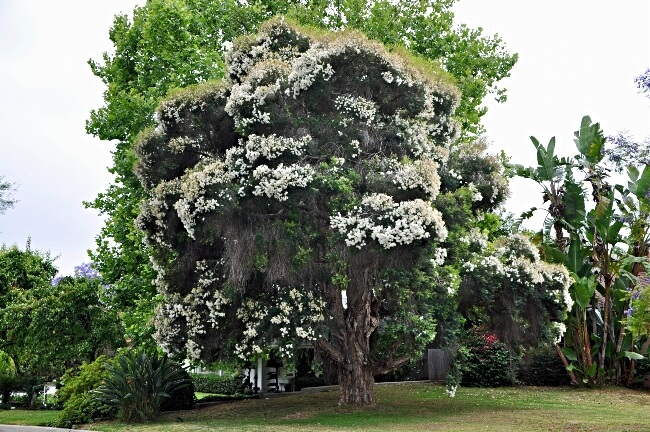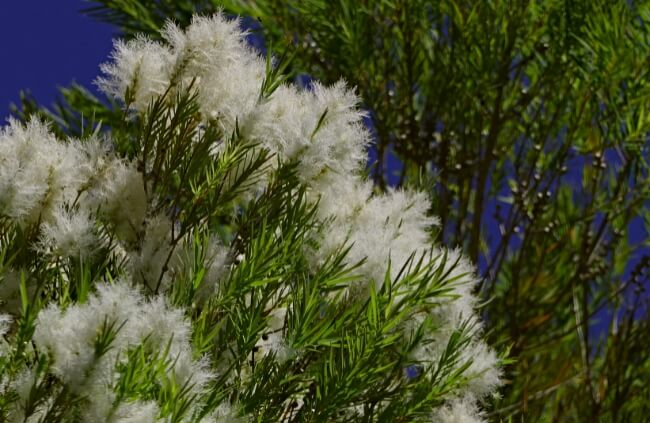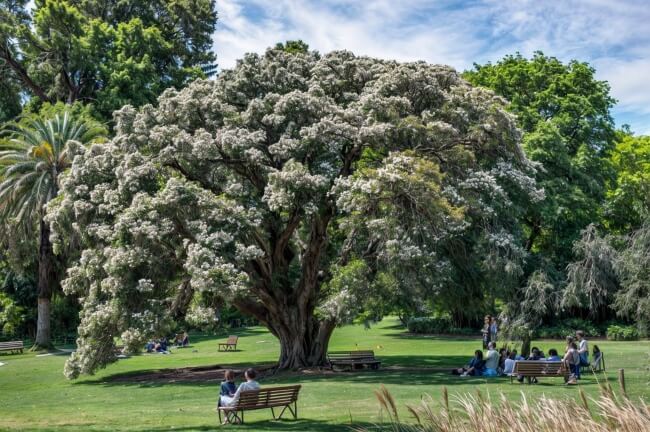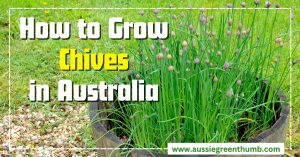Those familiar with my previous articles know that I absolutely adore white flowering specimens, and today, I have the privilege of introducing you to the stunning Melaleuca linariifolia!
This native shrub to small tree features prolific and fragrant fluffy snow-white flowers that envelop the plant from late spring to summer. This has to be one of our most popular Australian native plants for temperate garden ornamentals!
In today's growing guide, I will cover everything you need to know to grow and care for this spectacular native plant in your garden so you can make the most of this prized species!
More...

Source: PlantMaster
Family: | Myrtaceae |
|---|---|
Genus: | Melaleuca |
Species: | M. linariifolia |
Common names: | Australian native |
Origin: | Snow in summer, flax leaved paperbark |
Location: | Outdoor |
Type: | Shrub to small tree |
Growth: | 6 to 10 metres tall and wide |
Sun requirements: | Full sun to part shade |
Foliage colour: | Green |
Flower colour: | White |
Flowering: | Summer |
Maintenance level: | Low |
Poisonous for pets: | Plant oil can be mildly toxic to cats and dogs if consumed |
What is Melaleuca linariifolia?
The closeup tree blooming flowers are borne in spikes at the ends of branches, with lovely lanceolate leaves cushioning the surrounding area. The plant can even be found in the Royal Botanic Garden and is a favourite of the Australian Native Plant Society!
Part of the Myrtaceae family, Melaleuca linariifolia is also commonly known as snow in summer or the flax-leaved paperbark. Native to eastern Australia, the species occurs mainly in coastal NSW and the surrounding swampy regions with some found as far as Western Australia and South Australia. It prefers temperate climates.
In cultivation, the plant will reach about 6 to 10 metres tall and wide but can be grown as a large tree if there's enough space. Its growing speed is considered moderate.
For smaller gardens, the Melaleuca ‘Snowstorm’ and Melaleuca ‘Sea Foam’ cultivars are excellent alternatives!
Snow in summer will also attract beneficial insects and wildlife similar to tea trees, great for gardens aiming to be more sustainable.
Caution: The roots of flax-leaved paperbark can become extensive, so try to plant it away from any waterlines and structures. The plant is also easily ignitable, so be sure to plant it away from any potential sources of fire in the garden.
Common Uses for Melaleuca linariifolia:
- Feature shrub
- Street trees
- Screen or windbreak
- Gap filling
How to Grow Melaleuca linariifolia

For an easy and quick-to-establish route, you can find a young nursery plant in-store and online from many reputable Australian nurseries. Alternatively, this species can be reliably propagated using cuttings. Cuttings will ensure you get the desired characteristics of the parent plant whereas seeds are less reliable.
Take a healthy cutting from the current season's growth above the upper leaf axils that is at least 10cm long. Plant the cutting into a well-draining container, filled with a quality potting or propagation mix. Water well after planting then place the cutting in a warm sheltered location that gets indirect light.
Planting and Growing Conditions for Melaleuca linariifolia
- Soil - While the plant can adapt to many soil types, it does prefer sandy or heavier soils so long as the soil is well-draining.
- Sunlight - Pick a planting site that offers a sunny position. While full sun to part shade will do, more sun will ensure healthy vibrant foliage and prolific flowers.
Caring for Flax Leaved Paperbark
- Watering - Water regularly while the plant is young and developing. Once established, water occasionally but deeply when the soil is dry to the touch.
- Mulching - Apply a layer of mulch at the base of the shrub in summer to assist with soil moisture retention and to help regulate temperatures.
- Pruning - Remove dead, damaged and overgrown branches to maintain a tidy appearance. This species does tolerate regular pruning for those who wish to establish a smaller growing specimen.
- Fertilising - Apply a balanced, slow-release fertiliser from spring to summer to encourage healthy growth and flowering.
Melaleuca linariifolia Pests to Watch Out For
Melaleucas are generally healthy plants that can defend against serious pests and diseases. One pest that may become a problem is the webbing caterpillar.
Solutions: You can manually remove nests and webbing materials by cutting off affected branches. For severe infestations, you can chemically control them by using an organic neem oil spray for plants. This is best for a natural approach.
Melaleuca linariifolia Frequently Asked Questions

Source: IPlantz
What is the lifespan of Melaleuca linariifolia?
This hardy plant can live more than 100 years in optimal conditions like in the botanic gardens. In cultivation, large shrubs to small trees can easily live for 50 years or more.
How long does flax-leaved paperbark take to grow?
In good climates, these trees can grow about 1 metre per season. They will grow a little slower in cooler regions.
How do you propagate Melaleuca linariifolia?
While the species can be successfully propagated using seeds or cuttings, cuttings are the preferred method as they will maintain the desirable characteristics of the parent plant.
Why is Melaleuca linariifolia called snow in summer?
The plant's common name pays homage to its snow-white fluffy flowers that cover the tree throughout summer as bark flowers. This gives the appeal of a snowy canopy that can add wonderful charm to outdoor spaces!
What are the leaves of horticulture Melaleuca linariifolia?
This popular garden shrub produces opposite, narrowly elliptic to linear evergreen leaves. The foliage maintains its bright green allure year-round, making it a popular garden ornamental throughout Australia.
Is the snow in summer root system invasive?
The roots can grow quite extensively over time. We recommend planting the tree away from any waterlines or nearby structures to avoid issues.
In addition to Melaleuca linariifolia, we've also published another informative article on Melaleuca thymifolia. Explore this Melaleuca species to discover more about these fascinating plants.
Make the Most of Your Gardens Summery Charm with Melaleuca linariifolia!
So, there you have it, all the fantastic reasons why the flax-leaved paperbark is worth considering.
Whether for its exquisite blooms, attractive papery bark, dense canopy, or gorgeous evergreen willow-like foliage, Melaleuca linariifolia will certainly be perfect for adding an enchanting charm to almost any garden style or setting.
Published on September 28, 2023 by Lorri Hopkins
Last Updated on April 2, 2024




